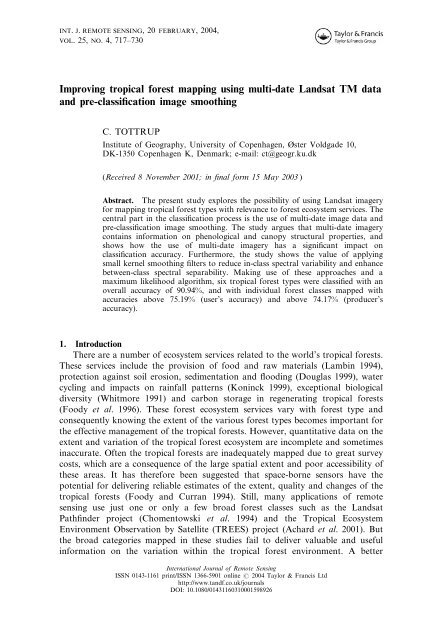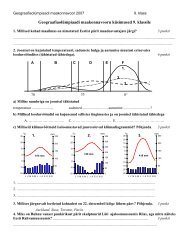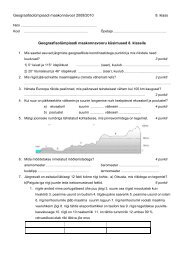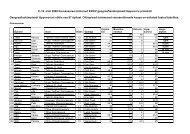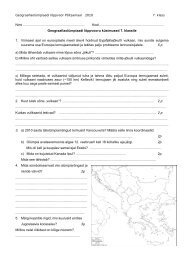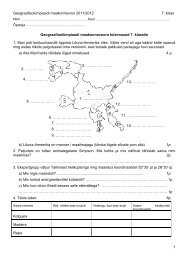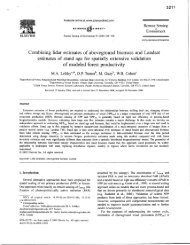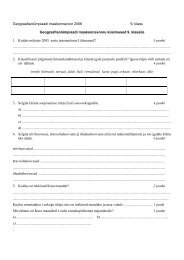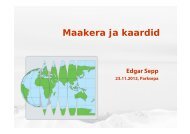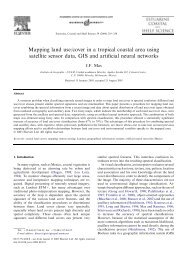Improving tropical forest mapping using multi-date Landsat TM data ...
Improving tropical forest mapping using multi-date Landsat TM data ...
Improving tropical forest mapping using multi-date Landsat TM data ...
Create successful ePaper yourself
Turn your PDF publications into a flip-book with our unique Google optimized e-Paper software.
INT. J. REMOTE SENSING, 20FEBRUARY, 2004,<br />
VOL. 25, NO. 4, 717–730<br />
<strong>Improving</strong> <strong>tropical</strong> <strong>forest</strong> <strong>mapping</strong> <strong>using</strong> <strong>multi</strong>-<strong>date</strong> <strong>Landsat</strong> <strong>TM</strong> <strong>data</strong><br />
and pre-classification image smoothing<br />
C. TOTTRUP<br />
Institute of Geography, University of Copenhagen, Øster Voldgade 10,<br />
DK-1350 Copenhagen K, Denmark; e-mail: ct@geogr.ku.dk<br />
(Received 8 November 2001; in final form 15 May 2003 )<br />
Abstract. The present study explores the possibility of <strong>using</strong> <strong>Landsat</strong> imagery<br />
for <strong>mapping</strong> <strong>tropical</strong> <strong>forest</strong> types with relevance to <strong>forest</strong> ecosystem services. The<br />
central part in the classification process is the use of <strong>multi</strong>-<strong>date</strong> image <strong>data</strong> and<br />
pre-classification image smoothing. The study argues that <strong>multi</strong>-<strong>date</strong> imagery<br />
contains information on phenological and canopy structural properties, and<br />
shows how the use of <strong>multi</strong>-<strong>date</strong> imagery has a significant impact on<br />
classification accuracy. Furthermore, the study shows the value of applying<br />
small kernel smoothing filters to reduce in-class spectral variability and enhance<br />
between-class spectral separability. Making use of these approaches and a<br />
maximum likelihood algorithm, six <strong>tropical</strong> <strong>forest</strong> types were classified with an<br />
overall accuracy of 90.94%, and with individual <strong>forest</strong> classes mapped with<br />
accuracies above 75.19% (user’s accuracy) and above 74.17% (producer’s<br />
accuracy).<br />
1. Introduction<br />
There are a number of ecosystem services related to the world’s <strong>tropical</strong> <strong>forest</strong>s.<br />
These services include the provision of food and raw materials (Lambin 1994),<br />
protection against soil erosion, sedimentation and flooding (Douglas 1999), water<br />
cycling and impacts on rainfall patterns (Koninck 1999), exceptional biological<br />
diversity (Whitmore 1991) and carbon storage in regenerating <strong>tropical</strong> <strong>forest</strong>s<br />
(Foody et al. 1996). These <strong>forest</strong> ecosystem services vary with <strong>forest</strong> type and<br />
consequently knowing the extent of the various <strong>forest</strong> types becomes important for<br />
the effective management of the <strong>tropical</strong> <strong>forest</strong>s. However, quantitative <strong>data</strong> on the<br />
extent and variation of the <strong>tropical</strong> <strong>forest</strong> ecosystem are incomplete and sometimes<br />
inaccurate. Often the <strong>tropical</strong> <strong>forest</strong>s are inadequately mapped due to great survey<br />
costs, which are a consequence of the large spatial extent and poor accessibility of<br />
these areas. It has therefore been suggested that space-borne sensors have the<br />
potential for delivering reliable estimates of the extent, quality and changes of the<br />
<strong>tropical</strong> <strong>forest</strong>s (Foody and Curran 1994). Still, many applications of remote<br />
sensing use just one or only a few broad <strong>forest</strong> classes such as the <strong>Landsat</strong><br />
Pathfinder project (Chomentowski et al. 1994) and the Tropical Ecosystem<br />
Environment Observation by Satellite (TREES) project (Achard et al. 2001). But<br />
the broad categories mapped in these studies fail to deliver valuable and useful<br />
information on the variation within the <strong>tropical</strong> <strong>forest</strong> environment. A better<br />
International Journal of Remote Sensing<br />
ISSN 0143-1161 print/ISSN 1366-5901 online # 2004 Taylor & Francis Ltd<br />
http://www.tandf.co.uk/journals<br />
DOI: 10.1080/01431160310001598926
718 C. Tottrup<br />
impression of the <strong>tropical</strong> <strong>forest</strong> environment and related ecosystem services could<br />
be achieved with greater classification detail and the full potential of remote sensing<br />
for distinguishing <strong>tropical</strong> <strong>forest</strong> types has still to be exploited (Hill and Foody<br />
1994). Detecting subtle vegetation changes in diverse <strong>tropical</strong> <strong>forest</strong> environments<br />
requires relatively high-resolution satellite sensor <strong>data</strong> and in this sense the <strong>Landsat</strong><br />
programme offers good value for money in terms of spatial and spectral resolution.<br />
The overall objective of the present study is to support <strong>tropical</strong> <strong>forest</strong> management<br />
by <strong>using</strong> satellite remote sensing to map <strong>tropical</strong> <strong>forest</strong> classes with relevance to<br />
<strong>forest</strong> ecosystem services. In that respect the immediate objectives are to evaluate<br />
the ability of the <strong>Landsat</strong> sensor to map <strong>tropical</strong> <strong>forest</strong> classes and to suggest some<br />
classification approaches that may be routinely used.<br />
2. Study area<br />
The study area is located in the upper Ca river basin in the province of Nghe An<br />
in north-central Vietnam, approximately 300 km south of Hanoi (figure 1). The Ca<br />
river flows in a south-eastern direction from Laos into Vietnam and through Nghe<br />
An province before it flows into the Bay of Tonkin.<br />
The area is located in a monsoon zone with a cold and dry season from<br />
November until March caused by the north-east monsoon and a hot and humid<br />
season due to the south-west monsoon (locally called the Lao wind) blowing from<br />
April to October. Average temperatures are 22–24‡C, with the highest temperatures<br />
Figure 1.<br />
Location map of the Ca River basin (grey region) and the study area (hatching).
Tropical <strong>forest</strong> <strong>mapping</strong> <strong>using</strong> <strong>Landsat</strong> <strong>TM</strong> <strong>data</strong> 719<br />
reaching 40‡C in June, while the lowest temperatures can drop to 5‡C around<br />
January. Annual precipitation in the upper Ca river basin is close to 1500 mm with<br />
a mean humidity of around 80–85% (Cuc et al. 1999). Nghe An province has the<br />
third largest <strong>forest</strong> cover in Vietnam although the distribution of <strong>forest</strong>land is<br />
highly variable within the province as a whole. Forests have been destroyed<br />
completely at lower altitudes, while de<strong>forest</strong>ation has been less destructive in the<br />
midland and mountain regions including the upper Ca river basin where around<br />
40% of the area remains <strong>forest</strong>ed (Cuc et al. 1999). The dominant <strong>forest</strong> formation<br />
is the broad-leafed evergreen and semi-deciduous <strong>tropical</strong> moist <strong>forest</strong> found within<br />
the lowland and lower montane zone. Although not as abundant in the upper Ca<br />
river basin, true deciduous <strong>forest</strong> might be found in smaller patches at lower<br />
altitudes. Steep limestone formations often referred to as karst are scattered<br />
throughout the study region, supporting a special <strong>forest</strong> environment mainly<br />
composed of broad-leafed evergreen trees and shrubs. Bamboo is the natural<br />
undergrowth invading abandoned croplands and rapidly growing back in <strong>forest</strong><br />
openings caused by dead falls or selective logging. Montane <strong>forest</strong> is found at<br />
altitudes above 1200 m above sea level and this <strong>forest</strong> formation is characterized by<br />
the absence of dominating trees and a canopy height typically not exceeding 10 m.<br />
The main human activities with respect to the <strong>forest</strong> environment are traditional<br />
shifting cultivation, farming by settled lowland migrants and logging practices. The<br />
latter is seen both as high-volume commercial logging and low-volume selective<br />
logging carried out by individuals or small groups (Tran et al. 2000, Tottrup 2002).<br />
3. Ground <strong>data</strong><br />
Ground <strong>data</strong> were collected during two field trips in the spring of 2000. The<br />
ground <strong>data</strong> were acquired at five main sites. The sites were selected to cover a<br />
range of physical and human environments believed to support different <strong>forest</strong><br />
types. All together 118 samples were collected and the information collected at each<br />
sample was geographical location, habitat, land cover, tree height and percentage<br />
canopy cover. The information was obtained <strong>using</strong> a Garmin 12XL Global<br />
Positioning System (GPS), compass, clinometer and measuring tape. As real time<br />
acquisitions of <strong>Landsat</strong> Enhanced Thematic Mapper (E<strong>TM</strong>)z/Thematic Mapper<br />
(<strong>TM</strong>) <strong>data</strong> could not be guaranteed, an important aspect of the ground<br />
observations was to reveal whether the visited sites had undergone changes since<br />
the latest known available <strong>Landsat</strong> <strong>TM</strong> images from 1998. Moreover, photos and<br />
sketches were taken and drawn at most points. All information was recorded on a<br />
check-sheet and after the fieldwork was completed a <strong>data</strong>base was created referring<br />
all coordinates to their respective attributes. Additionally ground <strong>data</strong> were<br />
available from the European Commission supported programme ‘Social <strong>forest</strong>ry<br />
and nature conservation in Nghe An province’. These ground <strong>data</strong> were collected in<br />
1997, 1999 and early 2000. Part of these <strong>data</strong> was used as support for the<br />
classification process while the other part was used as independent reference <strong>data</strong> in<br />
the accuracy assessment.<br />
4. Methodology<br />
Tropical <strong>forest</strong> <strong>mapping</strong> from satellite imagery is normally performed <strong>using</strong><br />
either supervised and/or unsupervised classification techniques. The spectral<br />
complexity of <strong>tropical</strong> <strong>forest</strong> classes has further led to numerous suggestions for<br />
procedures and techniques to improve classifications including for example<br />
stratification by ecological zone (Thenkabail 1999, Helmer et al. 2000), topographic
720 C. Tottrup<br />
normalization (Colby and Keating 1998), spatial filtering (Hill and Foody 1994),<br />
image segmentation (Hill 1999), object-oriented classifications (Foody et al. 1996),<br />
vegetation indices (Boyd et al. 1996, Helmer et al. 2000) and <strong>multi</strong>-temporal image<br />
<strong>data</strong> (Lucas et al. 1993). However, no standardized classification approach has been<br />
developed for <strong>tropical</strong> <strong>forest</strong> <strong>mapping</strong> as the approaches vary according to<br />
objectives and scale of study, environmental settings and software abilities<br />
(Thenkabail 1999). In the following it is suggested that pre-classification image<br />
smoothing and the use of <strong>multi</strong>-<strong>date</strong> information has the potential for improving<br />
<strong>tropical</strong> <strong>forest</strong> <strong>mapping</strong> as well as being routinely used, not the least, due to their<br />
sound rationality and ease of implementation. Both methodologies have<br />
individually produced promising results (e.g. Conese and Maselli 1991, Hill and<br />
Foody 1994) and in the present study their individual and combined ability to<br />
improve <strong>tropical</strong> <strong>forest</strong> <strong>mapping</strong> was evaluated <strong>using</strong> separability analyses,<br />
standard measures of accuracy and Kappa analyses. In the following the logic<br />
behind image smoothing and <strong>multi</strong>-<strong>date</strong> information are presented followed by a<br />
brief presentation of the image processing steps.<br />
4.1. Pre-classification image smoothing<br />
Low spectral separability of <strong>tropical</strong> <strong>forest</strong> types has been observed in <strong>Landsat</strong><br />
imagery (e.g. Singh 1987, Salas and Brunner 1998). This has mainly been attributed<br />
to the rapid regrowth, the constant high level of greenness and the density of the<br />
vegetation canopy (Salas and Brunner 1998) and to the complex texture of the<br />
reflectance patterns (Hill 1999). The textural complexity becomes especially evident<br />
in higher resolution imagery where it has been suggested that for <strong>tropical</strong> <strong>forest</strong><br />
classes the in-class spectral difference is significant relative to the between-class<br />
spectral variation (Thenkabail 1999, Hill 1999). However, the use of preclassification<br />
image smoothing could suppress the influence of in-class spectral<br />
variance while enhancing the between-class spectral separability. A smoothing filter<br />
reduces the in-class spectral variability by averaging the pixel values inside a<br />
sizeable kernel moved throughout the image. The present study tested the above<br />
logic by evaluating the effect of smoothing filters on <strong>forest</strong> class spectral<br />
separability and classification accuracies. It is important to be aware that image<br />
smoothing may also blur edges between <strong>forest</strong> and other land cover classes and thus<br />
in heterogeneous landscapes only small sized kernels should be used (Hill 1999).<br />
4.2. Multi-<strong>date</strong> information<br />
Areas with complex topography and heterogeneous surfaces possess an extreme<br />
challenge to land cover classifications based on remote sensing. However, <strong>multi</strong><strong>date</strong><br />
acquisitions are likely to enhance classification possibilities because they<br />
supply spectral information related to changing phenological stages (Conese and<br />
Maselli 1991) and canopy roughness (Foody and Curran 1994). Variability in<br />
reflected energy with the geometry of illumination and observation might be a<br />
valuable indicator of canopy roughness (Foody and Curran 1994). Land cover<br />
classes are typically non-Lambertian, i.e. they display a class-specific angular<br />
reflectance response which is related to surface roughness. Thus <strong>forest</strong> studies<br />
combining spectral information from varying Sun angles could provide a unique<br />
spectral response pattern related to canopy roughness. Also vegetation shows well<br />
defined variations in spectral responses related to phenological cycles and the<br />
acquisition of satellite imagery from different seasons is expected to greatly enhance
Tropical <strong>forest</strong> <strong>mapping</strong> <strong>using</strong> <strong>Landsat</strong> <strong>TM</strong> <strong>data</strong> 721<br />
the discrimination performance of the satellite imagery (Conese and Maselli 1991).<br />
The present study investigated the above rationales by comparing single- and <strong>multi</strong><strong>date</strong><br />
classifications. The <strong>multi</strong>-<strong>date</strong> approach assumes that surfaces examined do<br />
not vary in extension and distribution between acquisition <strong>date</strong>s. On the other<br />
hand, it should also be evident that the acquisitions should not be too close in time<br />
as the success of the <strong>multi</strong>-<strong>date</strong> approach depends on phenological changes as well<br />
as Sun angle differences.<br />
4.3. Satellite sensor <strong>data</strong> and image processing<br />
Two near cloud-free <strong>Landsat</strong> <strong>TM</strong> images, from 15 May 1998 and 7 November<br />
1998, were acquired and co-registered. Thirty-six ground control points were used<br />
to rectify the November image to a U<strong>TM</strong> map projection (zone 48N, datum<br />
WGS84) <strong>using</strong> a nearest neighbour resampling routine that maintained the original<br />
30 m resolution. The second order polynomial transformation had an RMS error of<br />
0.87 pixels. The May image was then co-registered to the November image <strong>using</strong> an<br />
image-to-image registration and resampled with an estimated RMS error of<br />
0.37 pixels. Clouds and cloud shadows were masked out <strong>using</strong> visual interpretation<br />
and on-screen digitizing. All visible and infrared bands were available for the<br />
analyses. However, the thermal infrared bands were excluded due to their lower<br />
spatial resolution. Also the visible blue bands were excluded, as high minimum<br />
histogram entries and low <strong>data</strong> depths suggested that these bands were affected by<br />
atmospheric scattering and with only modest contribution to class separability.<br />
Consequently, the feature selection resulted in the following <strong>data</strong>sets: two single<strong>date</strong><br />
5-band combinations and a <strong>multi</strong>-<strong>date</strong> 10-band combination. Each of the<br />
feature sets was analysed in three different modes consisting of raw <strong>data</strong>, 363<br />
smoothed <strong>data</strong> and 565 smoothed <strong>data</strong>. Training and reference <strong>data</strong> were<br />
manually digitized <strong>using</strong> the ground truth information and various false colour<br />
composites. Training classes were grouped according to major physiognomic and<br />
structural properties and class separability was investigated <strong>using</strong> graphical displays<br />
and statistical analyses. The statistical analyses were based on the Jeffries–Matusita<br />
(JM) distance, which has an upper value of 1.414 (d2) indicating maximum<br />
separability and a lower value of 0 indicating no separability at all (Jensen 1996).<br />
Before the classification it was ensured that all training classes fulfilled the statistical<br />
requirement of approximating a Gaussian distribution. Training area statistics were<br />
extracted from each of the nine combinations of input bands and filtering modes<br />
and used as input for nine individual maximum likelihood classifications. During<br />
classifications all classes were set with equal a priori values and without any reject<br />
fraction. To remove salt-and-pepper noise the resulting images were cleaned <strong>using</strong> a<br />
363 kernel majority filter. In the final part of the study, the nine classification<br />
results were compared <strong>using</strong> standard measures of accuracy and Kappa analyses.<br />
The goal was to determine whether there was any statistical verification for <strong>using</strong><br />
pre-classification image smoothing and the more costly <strong>multi</strong>-<strong>date</strong> approach.<br />
5. Results and discussion<br />
5.1. Separability analysis<br />
The separability of <strong>forest</strong> types defined by their major physiognomic properties<br />
is seen in figure 2. It appeared that three <strong>forest</strong> types (evergreen shrub, bamboo and<br />
deciduous <strong>forest</strong>) displayed a high degree of spectral separability. However, the<br />
broad-leaf evergreen <strong>forest</strong> class had a spectral overlap with the karst <strong>forest</strong> class.
722 C. Tottrup<br />
Figure 2.<br />
Ellipse scattergraph of training samples for <strong>forest</strong> physiognomic properties (note:<br />
ellipses are one standard deviation from the mean).<br />
Still, the overlap was not considered serious as any classification error between<br />
these classes could be considered minor, as the karst <strong>forest</strong> constitutes a special type<br />
of broad-leaf evergreen <strong>forest</strong>. Instead it was explored whether it was possible to<br />
subdivide the broad-leaf evergreen <strong>forest</strong> class. Human disturbance was expected to<br />
have an impact on <strong>forest</strong> structural properties and therefore it was explored<br />
whether the broad-leafed <strong>forest</strong> class could be divided by means of canopy closure<br />
and tree height. It appeared that <strong>using</strong> only one of these structural properties did<br />
not allow for sufficient separability of subclasses (figures 3 and 4). However, by<br />
combining the structural properties it was possible to divide the broad-leafed<br />
evergreen <strong>forest</strong> into a primary <strong>forest</strong> class and a human disturbed <strong>forest</strong> class<br />
denoted by degraded <strong>forest</strong>. Degraded <strong>forest</strong> consisted of what in the field was<br />
designated as either young secondary <strong>forest</strong> or open <strong>forest</strong>. The former represents<br />
<strong>forest</strong> regrowth following clear-cutting activities such as logging and shifting<br />
cultivation, while the opening of <strong>forest</strong> at larger scales is mainly attributed to<br />
selective logging practices. For young secondary <strong>forest</strong>, canopy cover may exceed<br />
50% but tree height is below 15 m. In contrast the open <strong>forest</strong> class is characterized<br />
by an above 15 m tree height but a less than 50% canopy cover. As the two classes<br />
were similar in both spectral characteristics and land use (human intervention) it<br />
was found appropriate to merge them into a degraded <strong>forest</strong> class. A full<br />
description of the identified <strong>forest</strong> classes can be found in table 1.<br />
A <strong>multi</strong>dimensional tabular representation of <strong>forest</strong> class spectral separability<br />
<strong>using</strong> both raw and smoothed <strong>data</strong> is found in table 2. It appears that image<br />
smoothing has the potential for increasing class separability. Although separability<br />
could have been slightly improved further <strong>using</strong> a kernel of 767 pixels, it should be<br />
stressed that a balance between training class separability and a possible real world<br />
blurring must be considered. Especially, it is important to realize that training areas<br />
are chosen because of their rather large homogeneous extension and therefore they
Tropical <strong>forest</strong> <strong>mapping</strong> <strong>using</strong> <strong>Landsat</strong> <strong>TM</strong> <strong>data</strong> 723<br />
Figure 3.<br />
Ellipse scattergraph of training samples for tree height of the broad-leaf evergreen<br />
<strong>forest</strong> class (note: ellipses are one standard deviation from the mean).<br />
do not represent the true heterogeneity of the landscape. For that reason the kernel<br />
of 565 pixels was chosen as the optimal filter.<br />
The apparent success of image smoothing for enhancing the spectral recognition<br />
pattern of <strong>tropical</strong> <strong>forest</strong> types is probably related to <strong>forest</strong> structural patterns. For<br />
example, the spectral signature of degraded <strong>forest</strong> can appear as mature <strong>forest</strong> in<br />
any given pixel, while in some pixels mature <strong>forest</strong> can appear as degraded <strong>forest</strong>.<br />
Figure 4. Ellipse scattergraph of training samples for canopy closure of the broad-leaf<br />
evergreen <strong>forest</strong> class (note: ellipses are one standard deviation from the mean).
Table 1.<br />
Physiognomic and structural <strong>forest</strong> types within the upper Ca river basin in north-central Vietnam.<br />
Class name Description Subclass Description<br />
1. Primary <strong>forest</strong> Undisturbed broad-leaf evergreen and semi-deciduous<br />
<strong>forest</strong> stands. They are characterized by a canopy<br />
closure of more than 50% and tree height various<br />
from 18 m to as high as 45z m. Although designated<br />
primary <strong>forest</strong> this class includes areas that have been<br />
exposed to low-volume selective logging as well as old<br />
secondary <strong>forest</strong> (approximately w20 y).<br />
2. Karst <strong>forest</strong> Special <strong>forest</strong> type mainly found on the top and in<br />
the cracks of steep limestone formations.<br />
3. Deciduous <strong>forest</strong> True broad-leaf deciduous <strong>forest</strong> stands. Found below<br />
approximately 800 m above mean sea level.<br />
4. Degraded <strong>forest</strong> Forest areas with a considerable human disturbance.<br />
These areas might include <strong>forest</strong> growing back from<br />
clear-felling resulting from either shifting cultivation<br />
or logging (secondary <strong>forest</strong>) or areas affected by<br />
pronounced selective logging.<br />
5. Bamboo Areas dominated by bamboo. The term bamboo refers<br />
to old, naturally occurring bamboo areas as well as to<br />
second growth bamboo following clear felling. Finally<br />
some bamboo areas are the result of nursery and<br />
planting.<br />
6. Shrub Areas dominated by evergreen shrub and bushes<br />
reaching a height between 3–9 m. These areas are often<br />
associated with fallow vegetation (approximately 2–5 y).<br />
Some taller woody species might be interspersed.<br />
Montane <strong>forest</strong><br />
Open <strong>forest</strong><br />
Young secondary<br />
<strong>forest</strong><br />
Elfin and pine <strong>forest</strong>s found at altitudes<br />
from 1200z m above mean sea level.<br />
Broad-leafed evergreen and semi-deciduous<br />
<strong>forest</strong> areas where selective logging has taken<br />
place. Canopy closure is below 50% and tree<br />
height rarely exceeds 20z m. Shrub and<br />
bamboo are found in the openings followed<br />
by selective logging.<br />
Forest growing back in clear-cuts resulting<br />
either from agriculture or logging<br />
(approximately v20 y). Canopy closure may<br />
exceed 50% but tree height is less than 15 m.<br />
724 C. Tottrup
Tropical <strong>forest</strong> <strong>mapping</strong> <strong>using</strong> <strong>Landsat</strong> <strong>TM</strong> <strong>data</strong> 725<br />
Table 2.<br />
Measures of Jeffries–Matistuta derived from raw and smoothed <strong>multi</strong>-<strong>date</strong><br />
<strong>Landsat</strong> <strong>TM</strong> <strong>data</strong>.<br />
[0] [1] [2] [3] [4] [5]<br />
(a) Raw <strong>data</strong><br />
[0] Primary <strong>forest</strong> – 0.888 1.362 0.876 1.213 1.307<br />
[1] Karst – 1.341 0.916 1.205 1.279<br />
[2] Deciduous <strong>forest</strong> – 1.340 1.359 1.343<br />
[3] Degraded <strong>forest</strong> – 0.851 1.129<br />
[4] Bamboo – 1.026<br />
[5] Shrub –<br />
(b) 363 smoothed <strong>data</strong><br />
[0] Primary <strong>forest</strong> – 1.051 1.410 0.931 1.308 1.365<br />
[1] Karst – 1.413 1.106 1.362 1.368<br />
[2] Deciduous <strong>forest</strong> – 1.411 1.413 1.409<br />
[3] Degraded <strong>forest</strong> – 0.961 1.251<br />
[4] Bamboo – 1.169<br />
[5] Shrub –<br />
(c) 565 smoothed <strong>data</strong><br />
[0] Primary <strong>forest</strong> – 1.159 1.414 1.035 1.354 1.390<br />
[1] Karst – 1.414 1.186 1.393 1.398<br />
[2] Deciduous <strong>forest</strong> – 1.414 1.414 1.414<br />
[3] Degraded <strong>forest</strong> – 1.060 1.301<br />
[4] Bamboo – 1.214<br />
[5] Shrub –<br />
This also applies for other spectral similar classes such as degraded <strong>forest</strong> versus<br />
bamboo and bamboo versus shrub. It follows that this would lead to classification<br />
errors when analysing on a per pixel basis <strong>using</strong> raw <strong>data</strong>. However, these dissimilar<br />
spectral pop-ups are moderated in the smoothing process where deviating spectral<br />
values are replaced with an average value within a user-determined kernel.<br />
5.2. Classification accuracy<br />
The classification performances were evaluated <strong>using</strong> independent reference <strong>data</strong><br />
and standard measures of accuracy and Kappa analyses. A comparison of the<br />
overall accuracy, Kappa agreement and Zeta statistics for all nine classifications are<br />
found in table 3 while the resulting classification error matrix of the best achieved<br />
classification is seen in table 4.<br />
From table 3 it appears that all band combinations are significant at the 95%<br />
confidence level, i.e. they fail the null-hypothesis that the classifications are no<br />
better than a random assignment of pixels (Congalton 1991). Furthermore, the<br />
table clearly displays the strength of the methodology with generally improved<br />
accuracies when <strong>using</strong> image smoothing and a <strong>multi</strong>-<strong>date</strong> band combination. The<br />
success of the <strong>multi</strong>-<strong>date</strong> approach can be understood as a function of: (1) a<br />
sufficient time between image acquisitions that assured a different geometry of<br />
illumination caused by significant Sun angle changes; (2) the satellite scenes being<br />
acquired at different seasons and thus representing varying phenological stages. The<br />
argument that image smoothing and <strong>multi</strong>-<strong>date</strong> imagery produces better results can<br />
be further vali<strong>date</strong>d by <strong>using</strong> Kappa analyses to compare individual matrices two at<br />
a time to determine whether they are significantly different (Congalton and Green<br />
1998). A comparison of raw versus filtered <strong>data</strong> and of the single-<strong>date</strong> versus the<br />
<strong>multi</strong>-<strong>date</strong> approach are found in table 5.
726 C. Tottrup<br />
Table 3.<br />
Band combination<br />
Overall accuracy measures, Kappa analysis results and test of significance for<br />
individual maximum likelihood classifications.<br />
Filter<br />
Overall<br />
accuracy<br />
(%)<br />
Kappa<br />
statistic<br />
(%) Variance<br />
Z<br />
statistic*<br />
<strong>TM</strong> 2, 3, 4, 5 and 7 May 1998 None 59.39 46.90 0.0004208 22.9<br />
<strong>TM</strong> 2, 3, 4, 5 and 7 Nov. 1998 None 70.84 60.70 0.0004385 29.0<br />
<strong>TM</strong> <strong>multi</strong>-<strong>date</strong> 1998 None 79.57 72.56 0.0003292 40.0<br />
<strong>TM</strong> 2, 3, 4, 5 and 7 May 1998 363 smoothed 71.66 62.59 0.0003827 32.0<br />
<strong>TM</strong> 2, 3, 4, 5 and 7 Nov. 1998 363 smoothed 76.74 68.69 0.0003709 35.7<br />
<strong>TM</strong> <strong>multi</strong>-<strong>date</strong> 1998 363 smoothed 85.83 81.09 0.0002453 51.8<br />
<strong>TM</strong> 2, 3, 4, 5 and 7 May 1998 565 smoothed 79.34 72.30 0.0003472 38.8<br />
<strong>TM</strong> 2, 3, 4, 5 and 7 Nov. 1998 565 smoothed 76.03 68.43 0.0003485 36.6<br />
<strong>TM</strong> <strong>multi</strong>-<strong>date</strong> 1998 565 smoothed 90.94 88.40 0.0001745 66.1<br />
*Z c ~1.96 at the 95% confidence level. H 0 :K~0 is rejected when ZwZ c .<br />
Table 4.<br />
Classification error matrix. Based on the maximum likelihood classification of a<br />
565 smoothed <strong>multi</strong>-<strong>date</strong> <strong>Landsat</strong> <strong>TM</strong> <strong>data</strong>set.<br />
Classified<br />
Reference <strong>data</strong><br />
[0] [1] [2] [3] [4] [5] [6]<br />
Row<br />
total<br />
User’s<br />
accuracy<br />
(%)<br />
[0] Primary <strong>forest</strong> 335 2 0 2 0 0 – 339 98.82<br />
[1] Karst 0 142 0 0 0 0 – 142 100.00<br />
[2] Deciduous <strong>forest</strong> 0 0 59 0 0 0 – 59 100.00<br />
[3] Degraded <strong>forest</strong> 0 0 0 97 24 8 – 129 75.19<br />
[4] Bamboo 0 0 0 10 89 4 – 103 86.41<br />
[5] Shrub 0 0 0 5 7 101 – 113 89.38<br />
[6] Other 0 0 5 10 0 5 – 20<br />
Column total 335 144 64 124 120 118 – 905<br />
Producer’s<br />
100.00 98.61 92.19 78.23 74.17 85.59<br />
accuracy (%)<br />
Accurately classified pixels (along diagonal) 823<br />
Total number of pixels used for reference 905<br />
Overall classification accuracy 90.94%<br />
Overall Kappa statistics 88.40%<br />
Table 5.<br />
Kappa analysis results for the pairwise comparison of error matrices.<br />
Pairwise comparison I Z statistic* Pairwise comparison II Z statistic*<br />
Raw vs 565 smoothed<br />
(May 1998)<br />
Raw vs 565 smoothed<br />
(November 1998)<br />
Raw vs 565 smoothed<br />
(Multi-<strong>date</strong> 1998)<br />
9.1717 May 1998 vs November 1998 1.4686<br />
2.7593 May 1998 vs Multi-<strong>date</strong> 1998 6.6048<br />
6.5753 Nov. 1998 vs Multi-<strong>date</strong> 1998 8.3076<br />
*Z c ~1.96 at the 95% confidence level. H 0 :(K 1 2K 2 )~0 is rejected when ZwZ c .
Tropical <strong>forest</strong> <strong>mapping</strong> <strong>using</strong> <strong>Landsat</strong> <strong>TM</strong> <strong>data</strong> 727<br />
The figures in table 5 are consistent with the above arguments and show that it<br />
is statistically significant to apply image smoothing and incorporate <strong>multi</strong>-<strong>date</strong><br />
imagery when <strong>mapping</strong> <strong>tropical</strong> <strong>forest</strong> types. Besides, it is noteworthy that there is a<br />
statistical agreement between the two single-<strong>date</strong> approaches, i.e. classifications<br />
based on either May or November imagery do not differ significantly. In figure 5<br />
there is a presentation of the final <strong>forest</strong> and land cover map. Note that a number<br />
of non-<strong>forest</strong> classes have been mapped as well. However, due to lack of<br />
independent reference <strong>data</strong> the classification accuracy of the non-<strong>forest</strong> classes has<br />
not been assessed. Still, with regard to the specific objective concerning the <strong>forest</strong><br />
classes, it is important to stress that classification errors induced by non-<strong>forest</strong><br />
classes on <strong>forest</strong> classes is very limited (cf. table 4).<br />
6. Conclusion<br />
Information on <strong>tropical</strong> <strong>forest</strong> quality is essential for the effective management<br />
of <strong>forest</strong> resources since regarding the <strong>tropical</strong> <strong>forest</strong> as a homogeneous unit may<br />
over- or underestimate the ecosystem services provided by the <strong>tropical</strong> <strong>forest</strong>. It is<br />
therefore important to develop methodologies that can locate and quantify various<br />
types of <strong>tropical</strong> <strong>forest</strong>. The use of remote sensing has been suggested as a suitable<br />
and cost-efficient way to provide this information. The present study has<br />
Figure 5. Forest and land cover map of the upper Ca River basin in north-central Vietnam.<br />
The map is the result of a maximum likelihood classification of a 565 smoothed<br />
<strong>multi</strong>-<strong>date</strong> <strong>Landsat</strong> <strong>TM</strong> <strong>data</strong>set.
728 C. Tottrup<br />
demonstrated how <strong>Landsat</strong> <strong>TM</strong> <strong>data</strong> with simple classification approaches can be<br />
used to map several <strong>tropical</strong> <strong>forest</strong> types. Forest types were identified <strong>using</strong> <strong>forest</strong><br />
physiognomic and <strong>forest</strong> structural properties and the potential for <strong>mapping</strong> such<br />
<strong>forest</strong> types was evaluated <strong>using</strong> raw versus smoothed input <strong>data</strong> and single- versus<br />
<strong>multi</strong>-<strong>date</strong> image information. The use of separability analyses showed how small<br />
kernel pre-classification image smoothing effectively helped to reduce in-class<br />
spectral variability while enhancing between-class spectral differences. The impact<br />
on the classification was improved overall accuracies. This was further supported by<br />
Kappa analysis comparisons, showing a significant improvement in classifications<br />
based on smoothed input <strong>data</strong> relative to raw input <strong>data</strong>. Furthermore, the study<br />
argued that <strong>multi</strong>-<strong>date</strong> imagery contains information on canopy structural<br />
properties and phenological changes and has the potential to improve classification<br />
accuracies. The <strong>multi</strong>-<strong>date</strong> approach was tested against two single-<strong>date</strong> classifications<br />
and the value of <strong>using</strong> <strong>multi</strong>-<strong>date</strong> information was evident in terms of a higher<br />
overall classification accuracy and a statistical significant improvement in<br />
classification results. The highest classification accuracy was achieved when <strong>using</strong><br />
both pre-classification image smoothing and <strong>multi</strong>-<strong>date</strong> imagery. Doing that, it was<br />
possible to map six <strong>forest</strong> types with an overall accuracy of 90.94% and with<br />
individual <strong>forest</strong> types mapped with accuracies above 75.19% (user’s accuracy) and<br />
above 74.17% (producer’s accuracy). The simplicity and rationale of both preclassification<br />
image smoothing and <strong>multi</strong>-<strong>date</strong> imagery indicates that they have the<br />
potential for being routinely applied in <strong>tropical</strong> <strong>forest</strong> <strong>mapping</strong>. However, in an<br />
operational context, two aspects concerning the <strong>multi</strong>-<strong>date</strong> approach must be<br />
considered. The first is the increased cost of <strong>using</strong> an additional satellite scene,<br />
which could make the approach less attractive. However, the argument has lost<br />
some significance as the new pricing policy followed by the launch of <strong>Landsat</strong> 7<br />
now means that <strong>Landsat</strong> <strong>data</strong> can be obtained at very reasonable costs. Also, it can<br />
be expected that the cost of remote sensing <strong>data</strong> will decrease in the future as the<br />
number of instruments with Earth resource <strong>mapping</strong> capabilities increases.<br />
Secondly, the main limitation to a <strong>multi</strong>-<strong>date</strong> approach is the possibility of<br />
acquiring satellite scenes of adequate quality. The use of optical sensors in humid<br />
regions is hampered by high occurrences of clouds and thus the acquisition of<br />
several cloud-free satellite scenes at crucial times within a year can be difficult.<br />
Nevertheless, when successfully applied, the prospect of the study has high<br />
relevance for improved natural resource management as it gives an up-to-<strong>date</strong><br />
synoptic view of the state of the <strong>tropical</strong> <strong>forest</strong> with information related to <strong>forest</strong><br />
ecosystem services. The study, however, does indicate a number of recommendations<br />
for future research. For example, there is a need to elaborate methodologies<br />
that can distinguish between various classes of degraded <strong>forest</strong> as each class has its<br />
own economic, social and environmental impacts as well as its own management<br />
implications. In that sense microwave backscatter measured by Synthetic Aperture<br />
Radars (SAR) may have the potential to improve <strong>tropical</strong> <strong>forest</strong>s <strong>mapping</strong> by<br />
providing information on leaf and woody biomass as well as canopy roughness<br />
(Foody and Curran 1994). Furthermore, it appears that the only practical solution<br />
to cloud cover might be to increase the temporal resolution through a <strong>multi</strong>ple<br />
satellite sensor approach. This would enhance the possibility for acquiring cloudfree<br />
imagery and thus assure a better continuality in <strong>tropical</strong> <strong>forest</strong> inventories<br />
<strong>using</strong> satellite remote sensing. The latter is important as the dynamics of <strong>tropical</strong><br />
<strong>forest</strong> ecosystems should be investigated <strong>using</strong> satellite imagery with annual or nearannual<br />
repeatings.
Tropical <strong>forest</strong> <strong>mapping</strong> <strong>using</strong> <strong>Landsat</strong> <strong>TM</strong> <strong>data</strong> 729<br />
Acknowledgments<br />
I would like to thank Dr Michael Schultz Rasmussen from the Institute of<br />
Geography (University of Copenhagen) for his encouragement, good discussions<br />
and valuable advice. Moreover, I am grateful for the support from Dr Tran Duc<br />
Vien and his staff at the Centre for Agricultural Research and Ecology Studies<br />
(CARES) at Hanoi Agricultural University. In this respect a very special thank you<br />
to Dr Pham Tien Dung and Mai Van Thanh from CARES for their assistance<br />
during the field trips in Nghe An province. A thank you also to Stephen Leisz and<br />
‘Social <strong>forest</strong>ry and nature conservation in Nghe An province’ for <strong>data</strong> sharing and<br />
helpful advice. The financial support for the research came from the Danish component<br />
of the Resource Policy Support Initiative (REPSI) phase II 1999–2001 (administration<br />
by NORDECO and funding by DANIDA) and a grant from the World<br />
Wildlife Fund, ‘WWF Verdensnaturfonden/Novo Nordisk biodiversitetslegat’.<br />
I highly appreciate this support.<br />
References<br />
ACHARD, F., EVA, H., and MAYAUX, P., 2001, Tropical <strong>forest</strong> <strong>mapping</strong> from coarse spatial<br />
resolution <strong>data</strong>: production and accuracy assessment issues. International Journal of<br />
Remote Sensing, 22, 2741–2762.<br />
BOYD, D. S., FOODY, G. M., CURRAN, P. J., LUCAS, R. M., and HONZAK, M., 1996, An<br />
assessment of radiance in <strong>Landsat</strong> <strong>TM</strong> middle and thermal infrared wavebands for<br />
the detection of <strong>tropical</strong> <strong>forest</strong> regeneration. International Journal of Remote Sensing,<br />
17, 249–261.<br />
CHOMENTOWSKI, W., SALAS, B., and SKOLE, D. L., 1994, <strong>Landsat</strong> Pathfinder project<br />
advances de<strong>forest</strong>ation <strong>mapping</strong>. GIS World, 7, 34–38.<br />
COLBY, J. D., and KEATING, P. L., 1998, Land cover classification <strong>using</strong> <strong>Landsat</strong> <strong>TM</strong><br />
imagery in the <strong>tropical</strong> highlands: the influence of anisotropic reflectance.<br />
International Journal of Remote Sensing, 19, 1479–1500.<br />
CONESE, C., and MASELLI, F., 1991, Use of <strong>multi</strong>temporal information to improve<br />
classification performance of <strong>TM</strong> scenes in complex terrain. ISPRS Journal of<br />
Photogrammetry and Remote Sensing, 46, 187–197.<br />
CONGALTON, R. G., 1991, A review of assessing the accuracy of classifications of remotely<br />
sensed <strong>data</strong>. Remote Sensing of Environment, 37, 35–46.<br />
CONGALTON, R. G., and GREEN, K., 1998, Assessing the Accuracy of Remotely Sensed<br />
Data—Principles and Practices (Washington, DC: Lewis Publishers).<br />
CUC, L. T., TRAN, D. V., HUNG, D. T., and SON, H. V. (eds), 1999, Ca river basin<br />
environmental impact assessment. Center for National Resources and Environmental<br />
Studies (CRES), Hanoi, Vietnam.<br />
DOUGLAS, I., 1999, Hydrological investigations of <strong>forest</strong> disturbance and land cover impacts<br />
in South-East Asia: a review. Philosophical Transactions of the Royal Society of<br />
London, Series B, 354, 1725–1738.<br />
FOODY, G. M., and CURRAN, P. J., 1994, Estimation of <strong>tropical</strong> <strong>forest</strong> extent and<br />
regenerative stage <strong>using</strong> remotely sensed <strong>data</strong>. Journal of Biogeography, 21, 223–244.<br />
FOODY, G. M., PALUBINSKAS, G., LUCAS, R. M., CURRAN, P. J., and HONZAK, M., 1996,<br />
Identifying terrestrial carbon sinks: classification of successional stages in regenerating<br />
<strong>tropical</strong> <strong>forest</strong> from <strong>Landsat</strong> <strong>TM</strong> <strong>data</strong>. Remote Sensing of Environment, 55,<br />
205–216.<br />
HELMER, E. H., BROWN, S., and COHEN, W. B., 2000, Mapping montane <strong>tropical</strong> <strong>forest</strong><br />
successional stage and land use with <strong>multi</strong>-<strong>date</strong> <strong>Landsat</strong> imagery. International<br />
Journal of Remote Sensing, 21, 2163–2183.<br />
HILL, R. A., 1999, Image segmentation for humid <strong>tropical</strong> <strong>forest</strong> classification in <strong>Landsat</strong><br />
<strong>TM</strong> <strong>data</strong>. International Journal of Remote Sensing, 20, 1039–1044.<br />
HILL, R. A., and FOODY, G. M., 1994, Separability of <strong>tropical</strong> rain-<strong>forest</strong> types in the<br />
Tambopata-Candamo reserved zone, Peru. International Journal of Remote Sensing,<br />
15, 2687–2693.
730 Tropical <strong>forest</strong> <strong>mapping</strong> <strong>using</strong> <strong>Landsat</strong> <strong>TM</strong> <strong>data</strong><br />
JENSEN, J. R., 1996, Introductory Image Processing—A Remote Sensing Perspective (New<br />
Jersey: Prentice Hall).<br />
KONINCK, R. D., 1999, De<strong>forest</strong>ation in Vietnam. International Development Research<br />
Center, Ottawa, Canada.<br />
LAMBIN, E. F., 1994, Modelling De<strong>forest</strong>ation Processes: A Review. TREES Series B,<br />
Research Report No. 1, EUR 15744 EN (Brussels: European Commission).<br />
LUCAS, R. M., HONZAK, M., FOODY, G. M., CURRAN, P. J., and CORVES, C., 1993,<br />
Characterizing <strong>tropical</strong> secondary <strong>forest</strong>s <strong>using</strong> <strong>multi</strong>-temporal <strong>Landsat</strong> sensor<br />
imagery. International Journal of Remote Sensing, 14, 3061–3067.<br />
SALAS, B., and BRUNNER, J., 1998, Technical guide for change detection with <strong>multi</strong>temporal<br />
<strong>Landsat</strong> <strong>data</strong>: Ca river basin <strong>forest</strong> cover analysis. Complex Systems<br />
Research Centre, University of New Hampshire, USA. http://www.wri.org/pdf/<br />
repsi_brunner2.pdf.<br />
SINGH, A., 1987, Spectral separability of <strong>tropical</strong> <strong>forest</strong> cover classes. International Journal of<br />
Remote Sensing, 8, 971–979.<br />
THENKABAIL, P. S., 1999, Characterisation of the alternative to slash-and-burn benchmark<br />
research area representing the Congolese rain<strong>forest</strong>s of Africa <strong>using</strong> near real time<br />
SPOT HRV <strong>data</strong>. International Journal of Remote Sensing, 20, 839–877.<br />
TOTTRUP, C., 2002, De<strong>forest</strong>ation in the upper Ca river basin in north central Vietnam—a<br />
remote sensing and GIS perspective. Geographica Hafniensia C12, University of<br />
Copenhagen, Denmark.<br />
TRAN, D. V., HUONG, P. T., and RASMUSSEN, M. S., 2000, The social and environmental<br />
dimensions of changes in land use in the Ca river basin, Vietnam. In Institutions,<br />
Livelihoods and the Environment: Change and Response in Mainland Southeast Asia,<br />
edited by A. Straub (Copenhagen: Nordic Institute of Asian Studies).<br />
WHI<strong>TM</strong>ORE, T. C., 1991, An Introduction to Tropical Rain Forests (Oxford: Clarendon Press).


